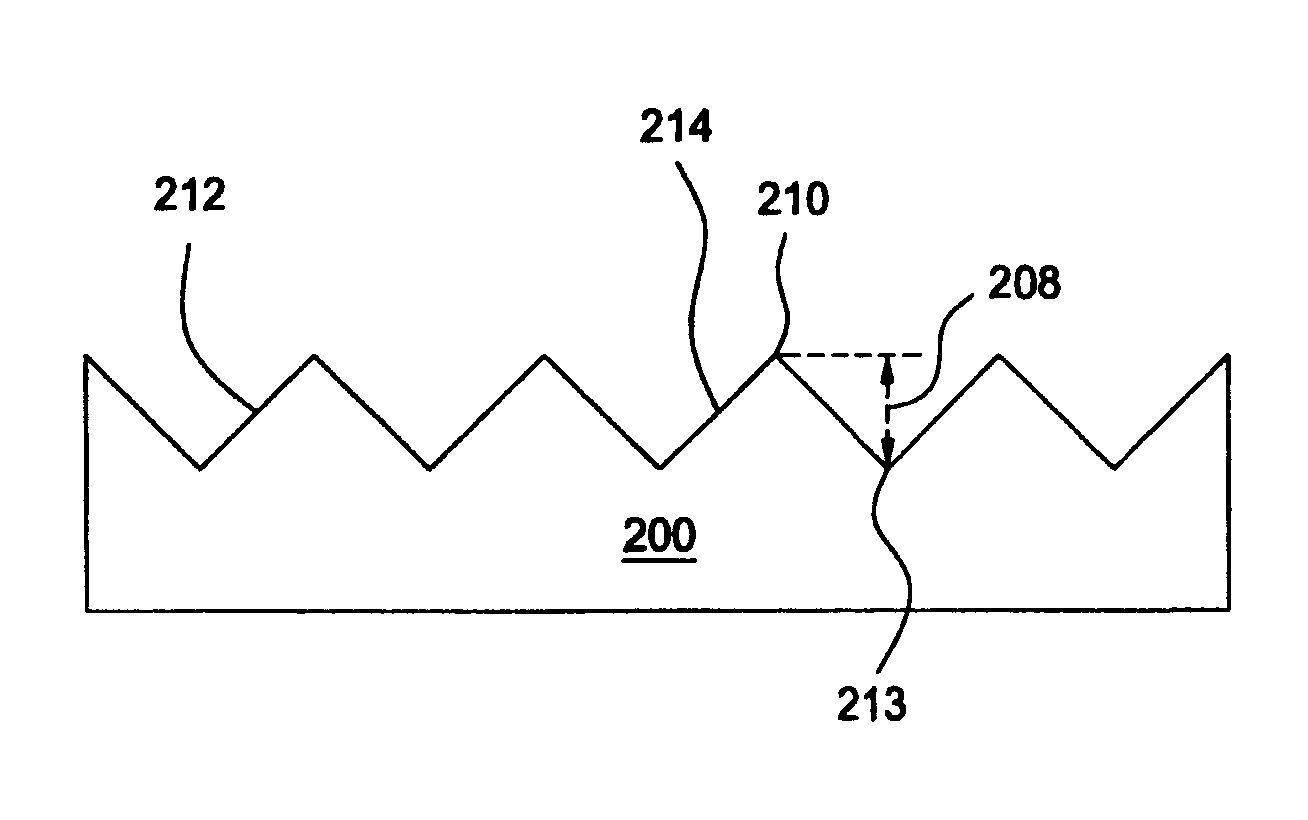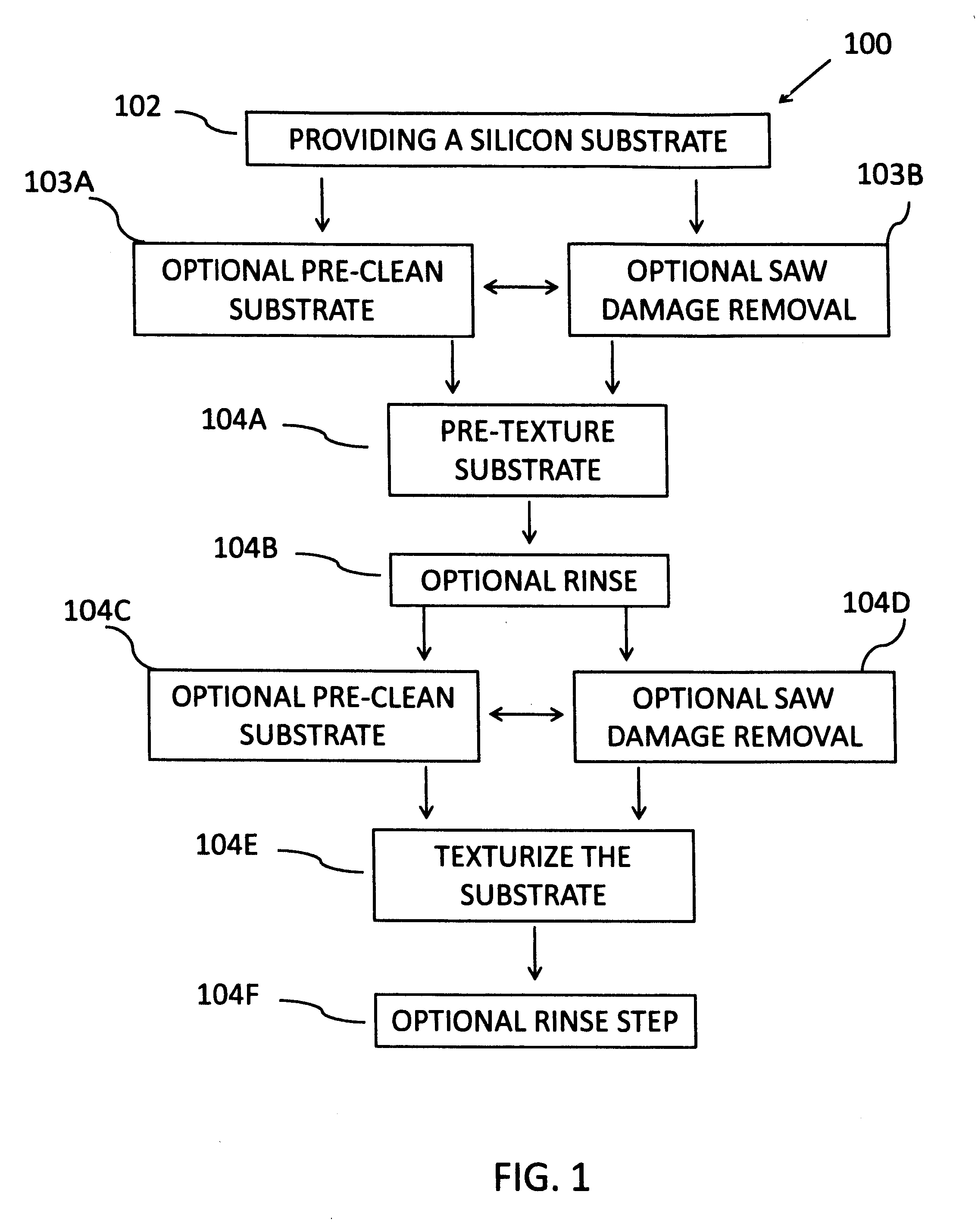Compositions and Methods for Texturing of Silicon Wafers
a technology of silicon wafers and compositions, applied in the direction of liquid displacement, sustainable manufacturing/processing, other chemical processes, etc., can solve the problems of increasing the throughput of the wafer processing, reducing the processing time of some embodiments, etc., to improve the uniformity of texturing, reduce reflectivity, and high density
- Summary
- Abstract
- Description
- Claims
- Application Information
AI Technical Summary
Benefits of technology
Problems solved by technology
Method used
Image
Examples
example 1
[0079]As-cut monocrystalline solar grade wafers were obtained from two different sources. These wafers were treated in various process sequences to achieve texturing on the surface.
[0080]In some of the processes of the examples, wafers were treated with a solution, herein referred to as Formulation 1 consisting of 4 wt % oxalic acid and 1.5 wt % Hostapur® SAS (purified by ion exchange) and the balance DI water.
[0081]Three different texturing processes were used to process the wafer pieces. The three different processes (A, B and C) were as follows with the process steps labeled (i, ii and iii, etc) in the order in which they occurred:
[0082]Process A: (i) Saw damage removal in 20 wt % KOH solution (balance DI water) for 10 min at 80° C.; (ii) 3 min DI water rinse; (iii) texturing in a solution containing 4 wt % KOH and 2 wt % Isopropanol (IPA) (balance DI water) for 20 minutes at 80° C.; and (iv) 3 minute DI water rinse.
[0083]Process B: (i) Immersion in Formulation 1 for 5 minutes at...
example 2
[0088]As-cut monocrystalline wafers obtained from the third source were processed using Process C described for Example 1 except that the various pre-texturing formulations in Table 2 were substituted for Formulation 1 in Example 1. (Formulation 1 from Example 1 has been included in Table 2 also.)
TABLE 2Hostapur SASOxalic Acid(Purified acid form)WaterFormulation #Concentration (wt %)(wt %)(wt %)141.595.524096301.598.540.80.398.950.40.1599.45
[0089]Table 3 summarizes the average reflectance percentages and the nominal pyramid heights of the wafers from Example 2 and includes the data for Formulation 1 from Example 1 also.
TABLE 3Nominal Pyramid heightFormulation #Average Reflectance (%)(μm)112.991.9215.6713.45312.114412.635.75513.1311.77
[0090]This example shows that the presence of the surfactant in the pre-texturing composition reduces reflectance and pyramid height and that more than 0.15 wt % surfactant in the pre-texturing composition may be more preferred for some embodiments.
example 3
[0091]In order to study the effect of texturing time on pyramid structures the wafers from the second source were treated using Processes A, B and C; however, the texturing times for the wafers were varied. The texturing times used were 5 minutes, 10 minutes, 15 minutes and 20 minutes for each. SEMs were taken of representative of the wafers at a 65° tilt angle treated using each of the texturing times in each Process. The SEM for the wafer treated using Process A with a 5 minute texturing step is shown in FIG. 5A. The SEM for the wafer treated using Process A with a 10 minute texturing step is shown in FIG. 5B. The SEM for the wafer treated using Process A with a 15 minute texturing step is shown in FIG. 5C. The SEM for the wafer treated using Process A with a 20 minute texturing step is shown in FIG. 5D. The SEM for the wafer treated using Process B with a 5 minute texturing step is shown in FIG. 6A. The SEM for the wafer treated using Process B with a 10 minute texturing step is ...
PUM
| Property | Measurement | Unit |
|---|---|---|
| Fraction | aaaaa | aaaaa |
| Fraction | aaaaa | aaaaa |
| Fraction | aaaaa | aaaaa |
Abstract
Description
Claims
Application Information
 Login to View More
Login to View More - R&D
- Intellectual Property
- Life Sciences
- Materials
- Tech Scout
- Unparalleled Data Quality
- Higher Quality Content
- 60% Fewer Hallucinations
Browse by: Latest US Patents, China's latest patents, Technical Efficacy Thesaurus, Application Domain, Technology Topic, Popular Technical Reports.
© 2025 PatSnap. All rights reserved.Legal|Privacy policy|Modern Slavery Act Transparency Statement|Sitemap|About US| Contact US: help@patsnap.com



